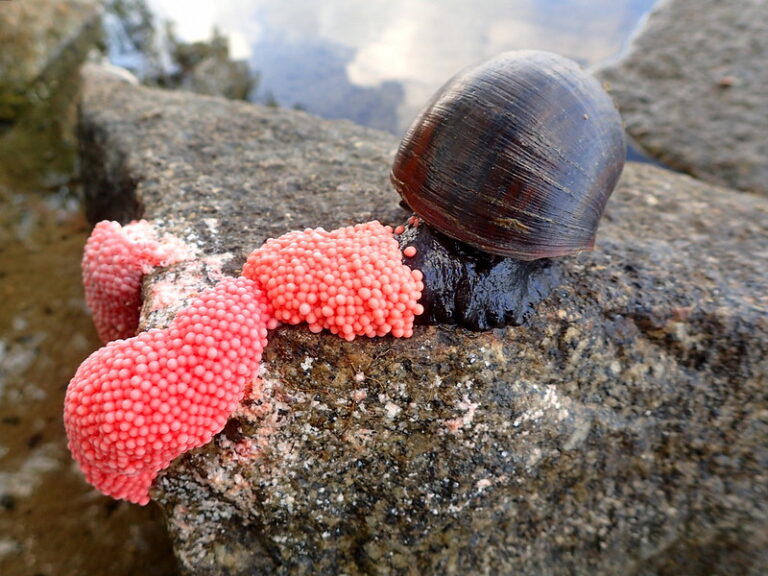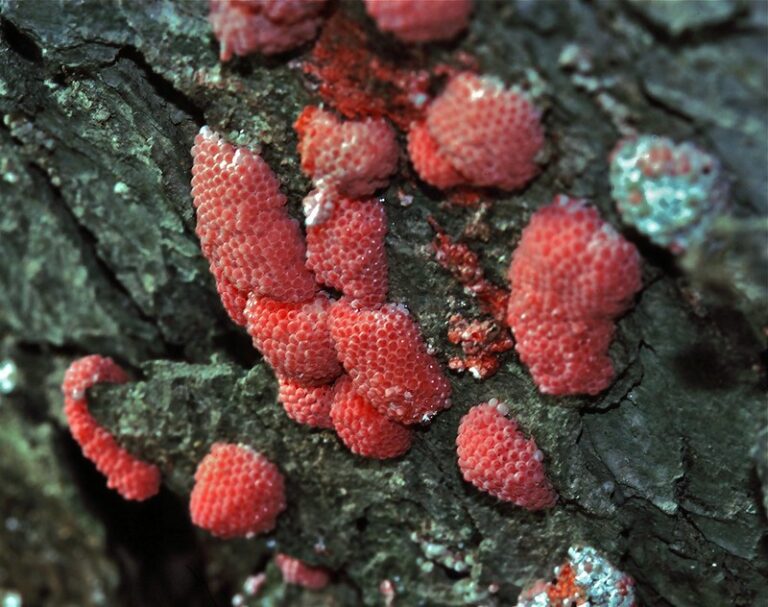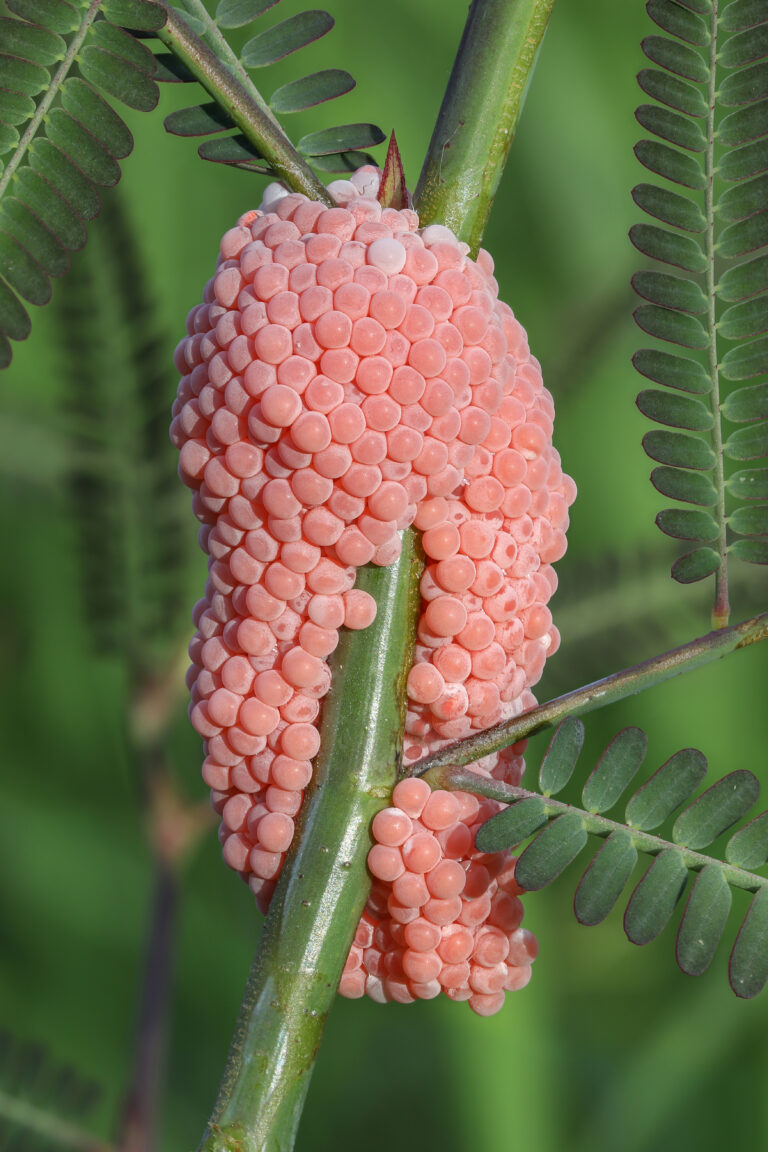If you’ve spotted groups of bright pink eggs in your garden, they may seem harmless at first, but don’t be deceived.
These striking eggs belong to the invasive apple snail, a harmful species that poses a serious threat to local ecosystems.
Native to South America, apple snails have spread across the globe, damaging plants, crops, and natural environments. Keep reading to discover why these snails are becoming an increasing concern and the potential impact they can have on your surroundings.
Popular in Aquariums, but a Growing Pest
Apple snails are quite popular in aquariums, particularly species like Pomacea bridgesii and Pomacea diffusa. They are favored because, unlike most snails, they do not feed on the plants in the tank.
Their popularity also stems from their unique appearance and size. Certain species can grow as large as 6 inches (15 cm), roughly the size of a baseball or human fist, making them one of the largest freshwater snails globally.

Some people refer to them as mystery snails or spike-topped apple snails. They come in various colors such as brown, albino, yellow, blue, purple, pink, and jade, and sometimes have distinctive banding patterns.
However, while they are popular in the aquarium hobby, some species of apple snails are considered pests in the wild, where they can damage plants and crops. Interestingly, in some regions, apple snails are even consumed and regarded as a delicacy.
Why Are Apple Snails So Invasive?
Apple snails are recognized as one of the 100 Worst Invasive Species worldwide, capable of causing significant damage to local ecosystems by outcompeting native species and harming aquatic environments.
With rising global temperatures, apple snails have been able to spread to new areas with more suitable conditions. They flourish in moist habitats such as ponds, lakes, and swamps, particularly in warmer climates, and have even evolved to endure land travel.
These snails are particularly adapted to tropical regions with alternating dry and wet seasons. They can even travel across land, utilizing a special “lid” (the operculum) to close their shells and prevent dehydration, waiting out dry spells by burying themselves in the mud.
Irresponsible Aquarium Dumping
Apple snails are originally found in areas such as South America, Central America, and the West Indies. However, when they spread outside their native regions, they can create serious environmental problems.
The spread of apple snails in the United States is mainly attributed to the careless disposal of aquarium pets. First reported in Texas in the 1970s, they have since spread to many other states. Louisiana confirmed their presence in 2006.
“The main idea is that they often get a little too large or maybe too abundant, and for whatever reason the aquarium owner decides they don’t want them anymore,” explains Bill Walton, a specialist at the Alabama Cooperative Extension System.
”So they decide to just release them in the waterways.”
From Culinary Ambition to Global Invasion
The apple snail issue is not a recent one.
In the 1980s, a species of apple snail was brought to Taiwan with the intention of starting an escargot industry. The aim was to provide an alternative protein source for farmers, who primarily relied on rice for their income.
However, what seemed like a promising idea quickly turned into a disaster. The snails not only failed to become a popular food item — at least, not among the locals — but they also brought along an unwelcome surprise: a parasite called Angiostrongylus cantonensis (rat lungworm). This parasite can pose serious health risks to humans if the snails are not cooked properly.
To make matters worse, instead of assisting local farmers, the snails began to threaten Taiwan’s rice crops and disrupt fragile ecosystems. As if that wasn’t enough, the snails spread quickly across Asia and eventually reached Hawaii, where they caused further harm to local agriculture and the environment.

In the United States, apple snails are regarded as a significant threat to agriculture, public health, and commerce, leading to calls for national quarantine measures.
The European Union took action by banning the sale and release of all apple snails in 2012 to prevent their rapid spread.
Apple Snail Eggs: What to Do If You Find Them
Apple snail eggs can actually look quite beautiful, with their bright, translucent pink or orange clusters that resemble little jewels glimmering in the sunlight. And did you know that each cluster contains between 500 and 700 eggs?
While they might be a stunning sight in your aquarium or pond, it’s important to remember that these colorful clusters can quickly lead to a snail invasion.
If you find apple snail eggs, it’s important to handle them carefully, as these snails can be harmful to aquatic ecosystems. Here’s what to do:
- Don’t Touch with Bare Hands: Apple snails can carry parasites that may affect both humans and pets. Always wear gloves when handling them.
- Remove the Eggs: Gently scrape the eggs off surfaces like plants, rocks, or tank walls using a plastic spatula or scraper. A soft brush can help if they’re stuck.
- Dispose of the Eggs Safely: Put the eggs in a sealed plastic bag, crush them, and throw them in the trash. Don’t flush them, as this could spread them to other water systems.
- Check for Snails: Inspect the area for any snails that may have hatched and remove them too. Apple snails reproduce quickly, so it’s important to act fast.
What kills Apple snails?
If you’re a gardener, the idea of apple snails taking over your garden can be alarming. One of the most effective ways to handle them is by eliminating their food, water, and shelter, forcing them to move elsewhere.
Apple snails are usually found in freshwater areas around your garden. Draining these water sources can drastically reduce their living space. Once the water is drained, you can remove any snails that are still present.

If you’re dealing with adult snails, freezing them is one of the simplest ways to kill them. For a permanent solution, place them in the freezer at 0°C for about 12 hours.
If you need to temporarily sedate them (to make handling easier), place them in the freezer at around 5°C for approximately 30 minutes. Afterward, dispose of them properly.
While addressing adult snails is important, the most effective approach is to focus on their next generation — the troublesome pink eggs. Removing and destroying these eggs as soon as you find them is crucial for preventing future infestations.
Conclusion
Dealing with apple snails can seem like a difficult task, but with some effort, you can safeguard your garden and prevent these pests from spreading.
By removing their eggs and addressing adult snails, you’ll ensure your plants stay protected and your water features remain in control. Keep in mind that acting swiftly is crucial and can make a significant difference.
Although apple snails are visually appealing, they are far from harmless. Their rapid reproduction and capacity to harm local ecosystems pose a serious risk to gardens and waterways.
By promptly removing eggs, freezing snails, and managing your garden’s water sources, you can help shield your environment from these invasive creatures.
Remember, staying alert and taking early action is the most effective defense against apple snails. Share this article to help raise awareness among your friends and family!

